
Lactuca, commonly known as lettuce, is a genus of flowering plants in the family Asteraceae. The genus includes at least 50 species, distributed worldwide, but mainly in temperate Eurasia.

Cyphostemma juttae is a slow-growing succulent species of Cyphostemma from southern Africa, well known as an ornamental plant.
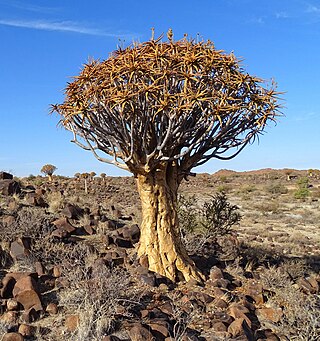
Aloidendron dichotomum, formerly Aloe dichotoma, the quiver tree or kokerboom, is a tall, branching species of succulent plant, indigenous to Southern Africa, specifically in the Northern Cape province of South Africa, and parts of Southern Namibia.

Ranunculus aquatilis, the common water-crowfoot or white water-crowfoot, is a plant species of the genus Ranunculus, native throughout most of Europe and western North America, and also northwest Africa.

Phyla nodiflora, commonly known as Lippia, Kurapia, and Frogfruit, is a species of flowering plant in the family Verbenaceae. It can be found in the Tropics around the globe. It is often grown as an ornamental plant for ground cover, and is often present in yards or disturbed areas.

Dombeya rotundifolia, the dikbas or "South African wild pear", is a small deciduous tree with dark grey to blackish deeply fissured bark, found in Southern Africa and northwards to central and eastern tropical Africa. Formerly placed in the Sterculiaceae, that artificial group has now been abandoned by most authors and the plants are part of an enlarged Malvaceae.
Micromeria imbricata var. imbricata is a variety of flowering plant in the family Lamiaceae, native to Africa and the Arabian Peninsula. Under the synonym Micromeria remota it was assessed as "least concern" when considered endemic to Socotra.

Aloe hereroensis is an African Aloe native to Angola, Namibia and South Africa. Like other Aloe species, it forms a rosette of succulent, lanceolate, greyish-green leaves with teeth along their edges. These leaves can grow up to 40 cm long. A. hereroensis forms large inflorescences, up to 1 meter high, with clusters of scarlet flowers.

Acanthus montanus, also known as bear's breech or mountain thistle and in Igbo;ogwu_ahga is a species of flowering plant in the genus Acanthus. It is native to tropical Africa, growing in wet and shady places like stream borders in Sierra Leone in West Africa and from Benin to Chad, Zambia, and Angola in central Africa.

Arctostaphylos imbricata is a species of manzanita known by the common name San Bruno Mountain manzanita.

The hawksbill sea turtle is a critically endangered sea turtle belonging to the family Cheloniidae. It is the only extant species in the genus Eretmochelys. The species has a global distribution that is largely limited to tropical and subtropical marine and estuary ecosystems.

Cyperus laevigatus is a species of sedge known by the common name smooth flatsedge.

Eretis djaelaelae, commonly known as the marbled elf, is a species of butterfly in the family Hesperiidae. It is found from Somalia southwards to South Africa. The habitat consists of savanna woodland and sometimes also grassland. Similar to Eretis umbra but has white forelegs.

Junonia natalica, the Natal pansy or brown pansy, is a butterfly of the family Nymphalidae. It is found in the Afrotropical realm.
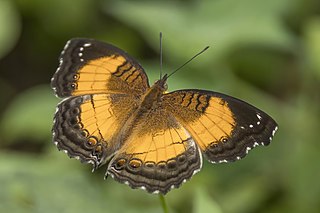
Junonia terea, the soldier pansy or soldier commodore, is a butterfly of the family Nymphalidae. The species was first described by Dru Drury in 1773. It is found in the Afrotropical realm.

Cordia africana or Sudan teak is a mid-sized, white-flowered, evergreen tree in the borage family (Boraginaceae), native to Africa. It produces edible fruit, and its wood is used for drums or other carpentry.
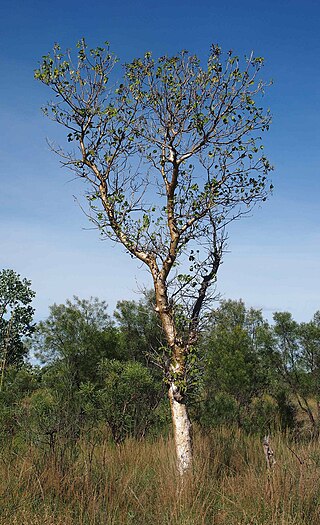
Gyrocarpus americanus is a flowering plant in the Hernandiaceae family, with a wide pantropical distribution. Its common names include the helicopter tree, propeller tree, whirly whirly tree, stinkwood or shitwood.

Junonia orithya is a nymphalid butterfly with many subspecies occurring from Africa, through southern and south-eastern Asia, and in Australia. In India, its common English name is the blue pansy, but in southern Africa it is known as the eyed pansy as the name blue pansy refers to Junonia oenone. In Australia, this butterfly is known as the blue argus, but this name also is used for the Aricia anteros in Europe.
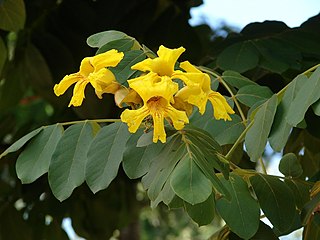
Markhamia lutea, the Nile tulip, Nile trumpet or siala tree is a tree species of the family Bignoniaceae, native to eastern Africa and cultivated for its large bright yellow flowers. It is related to the African tulip tree. Native to Africa, Markhamia was named in the honour of Clements Markham (1830-1916), who worked in India. An evergreen small tree that grows to 4–5 m in height outside of native zones, although it can reach more than 10 m in its zones of origin. Leaves, of 20–30 cm in length, normally arranged in groups in the ends of the branches. Flowers in terminal clusters. They are trumpet shaped, yellow in colour, with orange-reddish spots in the throat. They measure 5–6 cm in length. Fruit is a capsule, of up to 70 cm in length, with abundant winged seeds. It is propagated by seeds.
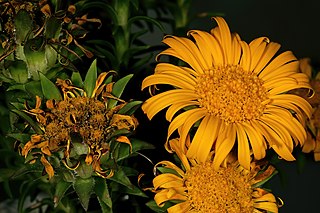
Oedera imbricata is a prickly shrublet belonging to the family Asteraceae.




















